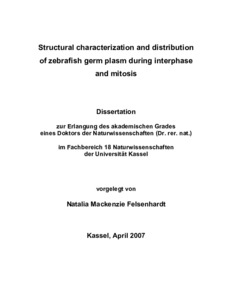| dc.date.accessioned | 2007-06-21T14:09:26Z | |
| dc.date.available | 2007-06-21T14:09:26Z | |
| dc.date.issued | 2007-06-21T14:09:26Z | |
| dc.identifier.uri | urn:nbn:de:hebis:34-2007062118729 | |
| dc.identifier.uri | http://hdl.handle.net/123456789/2007062118729 | |
| dc.format.extent | 13241 bytes | |
| dc.format.extent | 2612466 bytes | |
| dc.format.mimetype | application/pdf | |
| dc.format.mimetype | application/pdf | |
| dc.language.iso | eng | |
| dc.rights | Urheberrechtlich geschützt | |
| dc.rights.uri | https://rightsstatements.org/page/InC/1.0/ | |
| dc.subject | germ plasm | eng |
| dc.subject | zebrafish | eng |
| dc.subject | mitosis | eng |
| dc.subject | microtubule | eng |
| dc.subject | Dynein | eng |
| dc.subject.ddc | 570 | |
| dc.title | Structural characterization and distribution of zebrafish germ plasm during interphase and mitosis | eng |
| dc.type | Dissertation | |
| dcterms.abstract | In zebrafish, germ cells are responsible for transmitting the genetic information from one generation to the next. During the first cleavages of zebrafish embryonic development, a specialized part of the cytoplasm known as germ plasm, is responsible of committing four blastomeres to become the progenitors of all germ cells in the forming embryo.
Much is known about how the germ plasm is spatially distributed in early stages of primordial germ cell development, a process described to be dependant on microtubules and actin. However, little is known about how the material is inherited after it reorganizes into a perinuclear location, or how is the symmetrical distribution regulated in order to ensure proper inheritance of the material by both daughter cells. It is also not clear whether there is a controlled mechanism that regulates the number of granules inherited by the daughter cells, or whether it is a random process.
We describe the distribution of germ plasm material from 4hpf to 24hpf in zebrafish primordial germ cells using Vasa protein as marker. Vasa positive material appears to be conglomerate into 3 to 4 big spherical structures at 4hpf. While development progresses, these big structures become smaller perinuclear granules that reach a total number of approximately 30 at 24hpf. We investigated how this transformation occurs and how the minus-end microtubule dependent motor protein Dynein plays a role in this process.
Additionally, we describe specific colocalization of microtubules and perinuclear granules during interphase and more interestingly, during all different stages of cell division. We show that distribution of granules follow what seems to be a regulated distribution: during cells division, daughter cells inherit an equal number of granules. We propose that due to the permanent colocalization of microtubular structures with germinal granules during interphase and cell division, a coordinated mechanism between these structures may ensure proper distribution of the material among daughter cells. Furthermore, we show that exposure to the microtubule-depolymerizing drug nocodazole leads to disassembly of the germ cell nuclear lamin matrix, chromatin condensation, and fusion of granules to a big conglomerate, revealing dependence of granular distribution on microtubules and proper
nuclear structure. | eng |
| dcterms.abstract | Keimzellen sichern als Vorläuferzellen von Eizelle und Spermium die Weitergabe der genetischen Information von einer Generation zur Nächsten. Während der ersten Zellteilungen der frühen Embryogenese werden vier Blastomere durch die Aufnahme eines spezialisierten Teils des Zytoplasmas, dem Keimplasma, als Vorläuferzellen aller Keimzellen des sich entwickelnden Embryos festgelegt.
Die asymmetrische Vererbung des Keimplasmas in der frühen embryonalen Entwicklung ist gut untersucht und wird durch Mikrotubuli und Aktin gesteuert. Die Vererbung des Keimplasmas nach der perinukleären Reorganisation und die Mechanismen, die die korrekte Verteilung auf beide Tochterzellen sicherstellen, sind jedoch weitestgehend unerforscht. In dieser Arbeit wird die Verteilung des Keimplasmas in der Zeit der symmetrischen Zellteilung von 4 Stunden bis 24 Stunden nach der Befruchtung anhand des Keimplasmamarkers Vasa beschrieben. 4 Stunden nach der Eibefruchtung sammelt sich Vasa-positives Material in drei bis vier großen, sphärischen Granula an, die sich im Laufe der ersten 24 Stunden zu etwa 30 kleineren perinukleären Granulae aufteilen. Wir untersuchen die Kolokalisation von Mikrotubuli und perinukleären Granula in allen Zellzyklusstadien und zeigen dass Mikrotubuli und deren Motorproteine die Struktur und Reorganisation von Granulae ermöglichen. Weiterhin scheint die Vererbung der Granulae einer geregelten Verteilung zu unterliegen, da eine gleiche Anzahl an Granula auf beide Tochterzellen während der Mitose verteilt wird. Analog zu der Reorganisation des Keimplasmas in kleinere Strukturen wird für die symmetrische Vererbung ein Mikrotubuli-abhängiger Mechanismus vorgeschlagen, der eine korrekte Verteilung des Keimplasmas auf beide Tochterzellen sicherstellt. Die Beobachtungen verdeutlichen, dass im Zebrafisch die Verteilung von Keimplasma in primordialen Keimzellen von Mikrotubuli und einer intakten Struktur des Zellkerns abhängig ist. | ger |
| dcterms.accessRights | open access | |
| dcterms.creator | Mackenzie, Natalia | |
| dc.contributor.corporatename | Kassel, Universität, FB 18, Naturwissenschaften, Institut für Biologie | |
| dc.contributor.referee | Schäfer, Mireille A. (Prof. Dr.) | |
| dc.contributor.referee | Schuh, Reinhard (PD Dr.) | |
| dc.date.examination | 2007-06-13 | |

